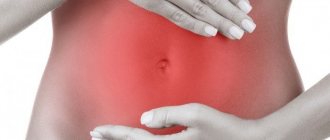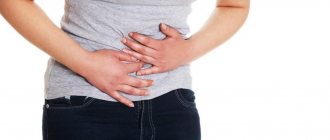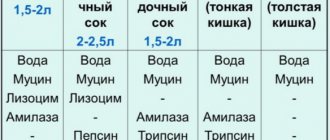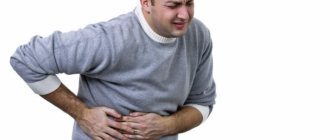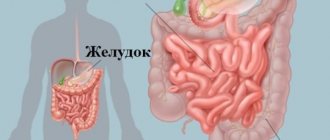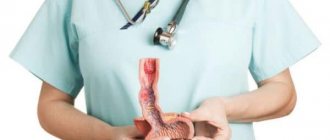Non-pathological factors causing pulsation
In women, pulsation often occurs during menstruation
This category includes conditions associated with physical activity and human nutrition:
- pulsation develops against the background of intense physical activity, most often occurring when consuming liquid or food immediately before training;
- Stressful situations can also cause an unpleasant sensation, because they are reflected in the stomach - it begins to vibrate and contract;
- VSD - a complex of symptoms is often associated with various neurological disorders, but they do not always indicate exclusively the disease;
- overeating - an active digestion process, stretching of the stomach walls that occurs with excessive food consumption can cause pulsation;
- structural features of the aorta in tall people - the organs are located close to this element of the circulatory system; changes in the stomach affect the aorta.
Overweight people also experience unpleasant symptoms in the abdominal area.
Pulsations below the navel often develop in women during menstruation, which is associated with active contraction of the uterus and separation of the endometrium. In addition to shaking and vibrations, many girls feel pain.
Non-pathological factors often cause pulsation in the center of the abdomen, left, right or below the navel. If the symptom appears rarely or is associated with factors of overeating or physical activity, then you should not worry. Things are different if the pulsation is accompanied by other symptoms that indicate the development of the disease.
Ripple Detection
Twitching can be detected during an ultrasound, but most often it is determined by a doctor by palpation. Normally, the abdominal aorta does not pulsate in rhythm with the contractions of the heart.
Since epigastric twitching often results from serious pathologies of the left or right ventricle, the detection of this symptom becomes a reason for additional examination by a cardiologist. In combination with the pulsation of the aneurysm, the vibration of the epigastrium gives doctors an idea of how much the vessel wall has changed and whether the pathology has grown significantly. If the symptom disappears in people diagnosed with an aneurysm, the doctor can confirm the presence of blood clots with almost 100% certainty.
Diseases as a cause of vibrations at the navel

There are several disorders and diseases in which pulsations in the navel area occur most often:
- Vascular disorders. The symptom develops in patients with atherosclerosis, when pressure increases due to vasoconstriction. But a similar sensation can also appear when the veins dilate excessively, as they lose their elasticity.
- Gastritis with high acidity. When the disease occurs, a spasm of the pylorus (antrum) occurs, and unpleasant symptoms develop. The pulsations are felt most strongly immediately after eating - irritation of the area occurs, and gastrointestinal motility is disrupted.
- Intestinal diseases. The organ takes up the most space in the body, and its diseases can manifest in different parts of the abdomen. If there is pulsation in the navel area, the development of an acute intestinal disease can be suspected. Sometimes this symptom provokes bloating and increased gas formation, as well as severe flatulence, which at the same time serve as signs of intestinal problems.
- Chronic enteritis is a disease in which the intestines become inflamed. It develops for various reasons: drug poisoning, viruses, infections, food intoxication. Symptoms often form a whole picture, including pulsation in the navel, pain, nausea, stool disturbances, lack of appetite and constant rumbling along the intestines. A long-term disease leads to a deterioration in the absorption of nutrients, against the background of which the patient experiences external changes: brittle hair and nails, dull skin, fatigue, weakness, bleeding gums.
- Intestinal obstruction. Pulsation in the navel will be associated with acute pain and intense bloating. Vomiting often occurs because processed food cannot be expelled naturally. Intestinal obstruction itself usually results from other diseases.
- Diverticulitis. It is accompanied by internal protrusions, due to which digestion is disrupted and prolonged constipation develops, followed by diarrhea. The temperature may rise. Blood impurities are often found in the stool. Diverticulitis often results from bacterial infection.
- IBS. Irritable bowel syndrome causes many symptoms, including pain and throbbing above the belly button. Often the disease is associated with the psychological and emotional state of the patient and worsens during periods of anxiety.
- Dysbacteriosis. An intestinal disease in which pathogenic microorganisms develop at high speed and displace natural bacteria of the gastrointestinal tract. Many unpleasant symptoms appear, including nausea and bloating.
Severe cases are much less common. With tumors, aortic aneurysm, and liver diseases, pulsation is one of the symptoms. Similar sensations can be observed even with heart disease.
Pulsations during pregnancy
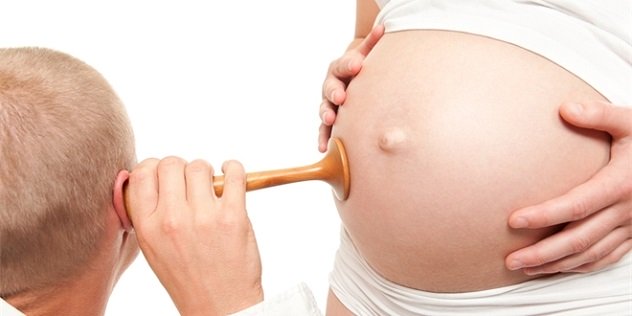
Pulsation is felt when the fetus hiccups
Over 80% of women, while carrying a child, experience a feeling of pulsation in the abdomen, in the navel area. This happens mainly at 28 weeks, when the uterus grows to the umbilical zone. Pulsations can be observed with hiccups affecting the fetus.
If a symptom is accompanied by other unpleasant sensations and persists for more than 2 days, it is better to consult a doctor to rule out pathologies. In later stages, strong pulsations may indicate compression of the vena cava, which runs along the spine. But we cannot exclude simple movement of the child, which also causes this symptom.
Diseases
Now let's take a closer look at why it can pulsate in the liver area. Despite the large number of possible causes of pain, we will still focus on the more common diseases. They are accompanied not only by discomfort in the liver area, but by other signs of organ damage.
Cardiac cirrhosis
The pathological condition is an overflow of the hepatic veins due to increased blood pressure in the inferior vena cava. As a result, stagnation occurs in the organ, which is accompanied by impaired blood supply to hepatocytes (liver cells), replacement of normal connective tissue and changes in the morphological structure of the organ.
In most cases, such disorders are observed against the background of pericarditis, with valvular abnormalities (stenosis, insufficiency).
The progression of cardiac diseases leads to the appearance of:

hepatomegaly, which indicates an increase in liver volume;- pulsating sensations, then pain in the hepatic space;
- ailments;
- swelling of the lower extremities;
- yellowness of the skin and mucous membranes;
- nausea, vomiting.
Due to the absence of nerve endings in the organ, liver pathology may not manifest itself as painful sensations for a long time, which is why the disease is often diagnosed at a late stage.
As for the clinical signs of the cardiovascular system, a person may be bothered by shortness of breath, pain in the heart area, cardiac arrhythmia, cough, and a feeling of fear.
With the progression of cardiac pathology, portal hypertension develops, which is characterized by ascites, visualization of veins on the anterior abdominal wall, as well as varicose changes in the esophageal veins.
The development of liver failure is caused by the death of a large number of hepatocytes and the inability to compensate for their function with healthy cells.
Echinococcosis
The development of the disease is based on infection of the body with the subsequent formation of cystic formations in the liver. Typically, parasites enter the human body due to non-compliance with hygiene rules, eating dirty vegetables and fruits.
Echinococcosis is the most common disease among helminthiases, which affects not only the liver, but also the brain, bone structures, and lungs. Involvement of the liver in the infectious process is observed in more than half of all cases of the disease.
The course of the disease often does not have pronounced symptoms. The first signs may appear several years after infection. Clinically the disease manifests itself:
- malaise;
- headache;
- skin rashes in the form of small dots;
- periodic low-grade fever;
- discomfort in the right hypochondrium, which is replaced by pulsation, heaviness;
- nausea, vomiting, worsening after abuse of fried, fatty foods;
- diarrhea associated with impaired digestion of fatty foods.
Symptoms are caused by the entry of toxic waste products of parasites into the bloodstream. After the cyst ruptures, an allergic reaction develops in the form of severe bronchospasm.
Among the frequent complications, suppuration of the contents of the cystic formation should be highlighted. After rupture of the latter, purulent peritonitis and pleurisy develop.
Chronic cholecystitis
The formation of an inflammatory focus in the gallbladder is accompanied by its dysfunction and stone formation (in some cases). The appearance of stones is caused by stagnation of bile, which is further complicated by infection of the bladder.
Warning signs
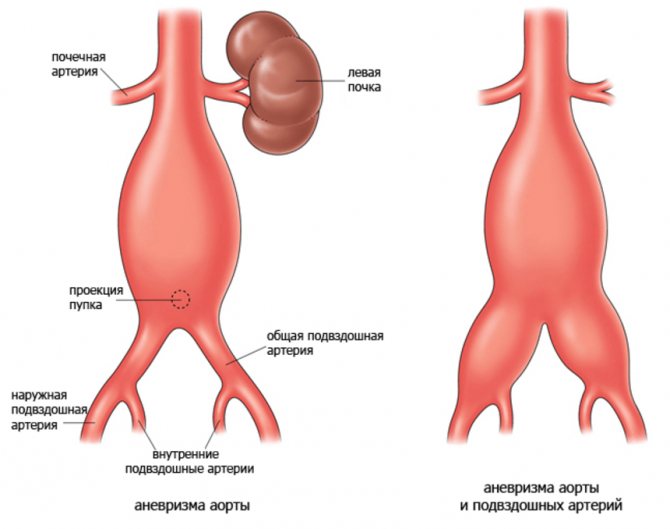
Pulsations usually indicate an aortic aneurysm - the most dangerous condition for this symptom. You can recognize it by the following additional symptoms:
- cramping pain that does not stop and is located just to the left of the navel;
- feeling of fullness even with minimal food intake;
- tingling feeling;
- pale skin on the legs is evidence of insufficient blood supply;
- Sensory impairment (in rare cases).
For an aneurysm up to 5 cm, doctors use conservative treatment methods; if the pathology has reached a larger size, they resort to surgery.
Pulsation in the pit of the stomach causes
Cor pulmonale, which is dilatation or hypertrophy of the right ventricle as a result of hypertension of the pulmonary circulation vessels, can also cause cardiomegaly.
Cause of cor pulmonale
The cause of the development of cor pulmonale is lung disease, damage to the pulmonary vessels, and deformation of the chest.
Three variants of cor pulmonale
There are three types of cor pulmonale: acute (develops over several hours, days), subacute (forms over weeks, months), chronic (lasts for years).
- Acute cor pulmonale
occurs with pulmonary embolism, status asthmaticus, valve pneumothorax, pneumomediastinum, and massive pneumonia. - Subacute cor pulmonale
is formed with repeated small thromboembolism of the pulmonary artery with the development of pulmonary infarction, and can also be observed with repeated asthmatic status. - Chronic cor pulmonale
is a complication of primary vascular hypertension of the pulmonary circulation, chronic bronchitis, bronchopulmonary diseases, spinal lesions and chest deformation, Pickwickian syndrome, polycystic pulmonary disease and some other processes in the lungs, in particular restrictive ones - fibrosis and granulomatosis, pleural cord.
Pathogenetic factors of cor pulmonale
The main pathogenetic factor in the formation of cor pulmonale is hypertension of the pulmonary circulation, caused by a decrease in the vascular bed due to obliteration, sclerosis, thromboembolism, or due to functional vasoconstriction, which can be caused by serotonin released during pulmonary embolism.
During obstructive processes in the lungs, the right ventricle works under heavy overload and in conditions of oxygen deficiency, which leads to myocardial dystrophy and decompensation of the pulmonary heart.
Chronic overload of the right ventricle, which occurs when resistance in the pulmonary circulation increases, leads to cardiomegaly.
Signs of cor pulmonale
In the differential diagnosis of cardiomegaly, clinical signs of cor pulmonale should be taken into account. In this case, pulsation in the pit of the stomach (under the xiphoid process), associated with hypertrophy of the right ventricle, is clearly visible.
The second tone above the pulmonary artery is intensified and often split, which indicates hypertension in the pulmonary circulation.
Cyanosis, reflecting severe hypoxia, confirms that cardiomegaly is due to chronic cor pulmonale.
Anamnesis data indicate the presence of chronic bronchopulmonary pathology. There is dilatation of the pulmonary artery, determined radiographically.
The shortness of breath is not orthopneic, which allows one to exclude cardiac dyspnea.
There are signs of right ventricular failure (congestive liver, kidneys, peripheral edema, increased venous pressure, swollen liver).
«Pulsation in the pit of the stomach, cyanosis, shortness of breath, other signs of cor pulmonale
» — article from the Cardiology section
Inquiries and appointments. Phones and WhatsApp:
What is the reason for hunger pains in the stomach?
Have you been struggling with GASTRITIS and ULCERS for many years without success?
Head of the Institute: “You will be amazed at how easy it is to cure gastritis and ulcers simply by taking it every day.
One ancient sage said that pain is the watchdog of health. By this, he meant that in this way the body signals about problems that need to be eliminated.
Our readers successfully use Monastic Tea to treat gastritis and ulcers. Seeing how popular this product is, we decided to bring it to your attention. Read more here...
Some acute pain requires immediate attention to a surgeon or other specialist, while others can be treated at home. What are the causes of hunger pain in the stomach, what to do when they appear?
Why does gastralgia occur during hunger?
The expression “hunger pain” refers to a pain syndrome that meets three main conditions:
- develops 6-7 hours after eating;
- appears after a person feels hungry, or at the same time;
- eliminated by eating or even water, even in minimal quantities.
Analogues of gastralgia during prolonged fasting are those that occur at night.
How to determine what hurts
Warning! The main cause of gastralgia in the absence of food in the stomach for a long time is a defect in the wall of the upper parts of the digestive tract, and most often in the duodenum or final parts of the stomach, in the form of erosion or ulcers. For peptic ulcer of the gastric fundus and body, pain syndrome that develops soon after eating is more typical.
Pain syndrome in peptic ulcer disease has the following characteristics:
- located in the area “under the stomach” - between two costal arches;
- occurs at night or in the morning, with a long period after eating;
- intensive;
- forces a person to take a certain position;
- can be described as a burning, aching, shooting, shooting, baking pain;
- goes away after taking milk, food, and sometimes water. The less food taken, the shorter the period of relief of gastralgia.
The following mechanisms underlie the appearance of hunger pain in the stomach:
- colonization of the mucous membrane by the bacterium Helicobacter;
- a 2-3-fold increase in the production of hydrochloric acid by parietal cells (night production of this acid also increases);
- irritation of nerve receptors going to the cells of the walls of the upper gastrointestinal tract by an increased amount of hydrochloric acid;
- muscle spasm around an erosive or ulcerative defect;
- disruption of the normal motor activity of the digestive tract.
All this occurs in the absence of food or weakly alkaline drinks, while the latter are a kind of buffer system that converts aggressive hydrochloric acid into less aggressive compounds. The results of such a biochemical reaction exist for a short period of time, then the newly released acid leads to the original situation.
Hunger pain of atypical localization
Gastralgia, which occurs after a long period of time after eating, is not necessarily localized “in the pit of the stomach.” It can also be described in the area of one of the hypochondriums.
Pain under the ribs on the left
The left hypochondrium contains the stomach, colon, and pancreas. This is also where heart pain comes from.
- When hunger pains occur in the left hypochondrium, this usually means that a person develops an erosive or ulcerative defect in the wall of the antrum of the stomach or duodenum, but due to the special innervation the pain is felt on the left.
- If the ulcer is formed in the gastric body, gastralgia can also occur in the left hypochondrium, but it develops 1.5-2.5 hours after eating, that is, it is not hungry.
- Malignant tumors of the stomach or pancreas do not cause pain.
- Diseases (especially inflammatory ones) affecting the pancreas are manifested by pain. The latter develops almost immediately after eating, especially if the food was fatty, spicy, or washed down with alcohol.
- Cardialgia radiating to the left hypochondrium is not associated with food, but with stress.
- Pain due to diseases of the spine, ribs and intercostal muscles can be localized in the left hypochondrium. Such pain syndrome will not be associated with hunger, but with certain movements.
Source: https://limto.ru/pulsacija-pod-lozhechkoj-prichiny/
Treatment options

At home, you can get rid of abdominal pulsations not caused by diseases like this:
- if a symptom appears in a lying or sitting position, you need to change your position - the sensation will pass within 10-15 minutes;
- if the symptom is caused by overeating, you can take a drug like Mezima to improve digestion;
- If your stomach is throbbing near the navel due to physical exertion, you can take a relaxing shower or do a light massage without pressing along the intestines.
For chronic gastritis or reflux, you can drink Gavixon syrup at night, which will prevent bile from being thrown into the stomach (for duodenitis).
If an unpleasant symptom appears during pregnancy, you should stop physical activity. A woman needs more rest, especially in the third trimester.
Therapy with sedative medications is used for IBS, as well as for severe stress and emotional tension. Only a doctor can prescribe potent drugs. If the symptom is caused by gastrointestinal diseases, the doctor may prescribe a course of treatment with enzymes (Festal, Mezim), laxatives and antispasmodics.
If pulsation occurs as a result of a diet violation, it is recommended to review the diet: eliminate heavy dishes, salty and spicy foods, and reduce portions.
What is a gastric aortic aneurysm?
If the body gives sudden signals, this indicates the development of pathological processes. Disturbances in the functioning of the gastrointestinal tract can manifest themselves as sensations of pulsation in the stomach area. The symptom is not a common complaint and appears less often than heartburn, pain, and nausea.
Description
When a sensation of pulsating fluttering in the stomach appears, an experienced specialist will take into account the clinical symptom. Pulsation in the area of the projection of the stomach signals the beginning of a pathological process with frequent manifestations.
The feeling of increased pulse in the abdominal muscle spreads to the anterior abdominal wall and brings discomfort to the person.
An increased pulse appears in serious pathological conditions of the abdominal wall organs, and in completely healthy people of all age categories.
Throbbing pain can vary in intensity - from mild discomfort to sharp pain. Normally, sensations of involuntary contraction occur if you remain in one position for a long time, especially an uncomfortable one. Intense physical activity and sports are provocateurs for the development of discomfort.
Nervous stress is often accompanied by spasms of the muscles of the gastric walls and peritoneum.
Changing positions will relieve tension from the muscles and reduce pressure from the abdominal wall.
To solve the problem, just change the uncomfortable position and lie on your side and relax. These actions will relieve tension from the muscles and reduce pressure from the abdominal wall.
If the measures brought a positive result, the pulsation passed without a trace, the condition is not a deviation or a symptom of a dangerous disease.
If the upper abdomen is constantly pulsating, the sensations gradually intensify and are accompanied by pain, nausea, you should definitely consult a doctor for advice.
The pulsation after exercise lasts longer, the sensations are localized in one place. But the condition is normal. You can make sure that this is not a consequence of pathology with a light massage of the abdominal muscles. If after these steps the sensations go away, consultation with a specialist is not required.
The stomach is pulsating in different places. Therefore, the pathology of a specific organ is determined by location. If the functioning of the main digestive organ is disrupted, the pulse of the abdominal muscle is felt to the left, just above the navel.
Disorders of this organ and intestines are manifested by pulsations in the middle part of the abdomen. This location corresponds to pathological vasodilation, which is characteristic of aortic aneurysms.
The pathological condition of the pancreas and its ducts is determined by vibrations in the peri-umbilical area on the right.
Causes of pulsation in the stomach
Gastric pulsation occurs with the development of many gastrointestinal diseases. But it is possible for a symptom to appear due to third-party pathologies that irradiate to the area of the projection of the stomach. Pulsation appears more often after eating and is accompanied by pain. The pain can be sharp, shooting, periodic, constant, aching. Often the reasons are physiological in nature. Provoking factors:
- Gastritis in acute or chronic aggravated condition.
- Tumor processes. Often, the presence of an increased pulse at the top of the anterior abdominal wall allows one to suspect cancer.
- Vascular changes. When the aorta narrows, which is often accompanied by atherosclerosis, the pressure inside the vessel increases, the blood flow is turbulent with an increase in pulse. In this case, the walls of the vessel gradually lose their elasticity, which prevents them from maintaining normal blood flow pressure. As a result, the person begins to feel a strong pulse.
- Formed aneurysm of the main vessel - the aorta. It is located in the retroperitoneal space. An aneurysm is characterized by persistent expansion with stretching of the aortic walls in one area. This happens due to morphological and functional changes in the walls. Aneurysms come in different shapes and sizes, most often sac-shaped or fusiform. In this case, the age group of patients is 60 years and older. The aneurysm manifests itself as a pulsation in the middle part of the abdomen. Additionally, with an aneurysm, pain, belching, and bloating appear. The patient begins to lose weight.
- Reduction in the diameter of the abdominal aorta without the formation of an aneurysm. The reason is the hardening of the walls of the aorta, which causes plaques to appear and pressure inside the blood vessels to increase. When blood flows through a constricted area under pressure, there is resistance to its flow. Therefore, pulsation of the peritoneum occurs.
- Pancreatitis. Usually, an increased pulse in the upper part of the abdominal wall is accompanied by severe girdle pain, heaviness, and a change in the state of ulcers during bowel movements.
- Liver pathologies. The organ may pulsate with visible enlargement, with the development of cirrhosis, hepatitis, and cholestasis.
- Dysfunction of the heart muscle. The upper abdomen pulsates with persistent diffuse expansion or thickening of the wall of the right ventricle of the heart, which is located above the xiphoid process. Increased fluttering is felt in the epigastric region.
- Mental disorders, central nervous system dysfunctions. Constant exposure to stress and psycho-emotional stress negatively affects the body, causing many pathological processes.
When overeating, the stomach works intensively, which causes pulsation.
In other cases, the reasons are physiological:
- Thin and tall. People of the asthenic type often feel a strong pulse in the upper abdomen due to the proximity of the aorta. This phenomenon is considered normal.
- Prolonged stay in an uncomfortable position, physical activity with muscle strain. The symptom is relieved by rest and light massage.
- Binge eating. Excess food in the stomach cavity causes the organ to work intensively, which causes pulsation.
- Hiccups. During shudders and sudden contractions of the diaphragm, sensations can be transmitted to the epigastric region.
- Early pregnancy. During this period, strong changes occur in all organs and systems of the body, especially in the blood vessels. Therefore, pulsation can accompany a pregnant woman until delivery. But in most cases, the reason lies in hiccups and slight movements of the fetal limbs.
Sometimes it pulsates in the upper part of the peritoneum in the morning on an empty stomach. This may be caused by spasms of the diaphragm, which is similar in mechanism to hiccups. The etiology of the condition is explained by the reflux of stomach acid into the esophagus passing through the diaphragm.
The process is aggravated by the horizontal position. When a person wakes up and begins to move, the tissues irritated by the acid contract. The duration of the sensation depends on the time of exposure to the stimulus.
Often the process is accompanied by heartburn or regurgitation.
https://www.youtube.com/watch?v=Ddyn3iASgdA
Pulsating sensations occur due to cardiac arrhythmia when body position changes during sleep. If pressure is applied to the heart area, the pulsation can last several minutes and radiate to the epigastric zone.
Measures to improve the condition
- With pulsating movements in the upper abdomen, there is no need to panic.
- You need to determine where it hurts and localize the sensations.
- The nature of the pulsation is set: constant, periodic.
- The strength of the pulsation is determined.
- You should check the variability of pulsation when changing body position, while eating, or when changing the amount of food or liquid consumed.
- Do you need to determine whether the peritoneum hurts when pulsating or not? If the answer is positive, the strength, character, and rhythm of the pain syndrome are assessed.
- If the pain is sharp and prolonged or there are already pathologies in the stomach and other internal organs, you need to consult a specialist.
- If you have morning pulsations in the upper abdomen, it is recommended to take a medicine at night that makes it difficult for stomach acid to flow into the esophagus, for example, Gaviscon.
- Pulsation in aortic aneurysm is eliminated by symptomatic treatment. Conservative therapy in this case is possible until the vessel walls rupture. A rupture of the aorta due to an aneurysm is repaired surgically. The prognosis for aortic aneurysm is poor.
To establish the etiological factors for the appearance of constant pulsation with pain of varying strength and sensations, it is recommended to undergo a diagnostic examination. Today the following are widely used:
- ultrasound diagnostics;
- CT scan;
- X-ray examination.
These methods allow you to obtain comprehensive data on the patient’s health status and make an accurate diagnosis.
Instrumental examination of the abdominal cavity makes it possible to choose the correct course of treatment for the underlying pathology.
With the primary manifestation of flutter in the epigastric region, that is, in an isolated case in a person without known pathologies of the gastrointestinal tract and other organs, the symptom does not pose a threat.
It is possible to use light sedatives to calm the patient, since pulsations often occur against the background of nervous overstrain or overexcitation. In this case, the stomach does not hurt, there is only discomfort after eating or physical activity. If pulsation in the stomach area recurs or persists, consultation with a therapist and gastroenterologist is required.
Prevention
The list of preventive measures depends on the etiological factors:
- With physiological provoking parameters, regular rest, nutritional control, and reduced physical activity are sufficient. Stressful situations and severe nervous tension should be avoided.
- If you have high acidity, it is recommended to take medications that reduce the secretion of gastric acid, such as Gastal. Espumisan is prescribed in the complex to reduce bloating.
- For digestive disorders, Creon is prescribed.
An effective preventive measure is a moderate diet with the temporary exclusion of fried, spicy, and fatty foods. Poor nutrition can cause discomfort such as pain in the upper abdomen.
Source: https://TvoyZheludok.ru/bolezni/pulsiruet-zheludok.html
Prevention of pulsations in the abdomen
Following a rational diet and moderate physical activity are the best means of preventing pulsations in the area above or near the navel. If a person is stressed, he needs to learn to reset negative emotions. Relaxation is promoted by meditation, evening walks, aromatherapy and engaging in your favorite hobby. Regular examinations of the gastrointestinal tract and the body as a whole are important in the prevention of pulsations - they will help prevent the development of serious diseases.
Pulsations in the navel area bother all people from time to time. There is no need to worry if they appear without additional symptoms and pass quickly. If pain, nausea, signs of dyspepsia, weakness and other unpleasant sensations occur, it is better to undergo diagnostics.
Prevention of the condition
For prevention, you can take a drug that reduces acidity (for example, Gastal) in combination with espumisan, which reduces bloating. As a supplement, you can drink Creon. It should be borne in mind that all these measures will be effective if you follow a gentle moderate diet. Eliminate fried, spicy and fatty foods from your diet for a while. If the symptoms disappear, try not to overindulge in junk food, and if possible, consult a specialist who will determine the diagnosis and prescribe a diet and treatment.
A huge number of processes occur in the human body every second. Some phenomena may arise spontaneously and stand out from the general normal picture. One of them is pulsation in the abdomen. It can occur in any person, and at any age.
Accordingly, the reasons for discomfort can be completely different. It is this issue that needs to be considered in more detail.
Diagnostics
Pulsation in the abdomen without pain or with severe discomfort is considered a reason to visit a doctor, as it may indicate various diseases. The specialist uses several diagnostic methods to identify the cause of the disorder.
| Method | Description | Venue and cost |
| General examination and questioning of the patient | The first and most important stage of diagnosis. The doctor interviews the patient, listens to his complaints, clarifies the conditions for the appearance of symptoms and the time during which they appear. After this, the specialist examines the patient, paying attention to the skin and palpation of the abdomen. Based on the data received, he prescribes additional diagnostics. | It is carried out in each clinic free of charge. |
| Clinical and biochemical blood test | Another standard research method in which blood is taken from a patient’s vein and sent to a laboratory. Thanks to this, it is possible to detect signs of inflammation and some other disorders indicating damage to the pancreas, liver or gallbladder. | The method is available for use in every clinic. In private institutions, the cost of diagnostics is approximately 400-600 rubles. |
| Laboratory examination of stool and urine | Such a study is necessary when the doctor suspects an infectious disease or damage to the urethra or bladder. The patient collects the material in special sterile containers and then brings it to the laboratory. Specialists study biological material and make a diagnosis. | It is carried out in every clinic, the price in private institutions is 300-500 rubles. |
| Ultrasound diagnostics of the abdominal cavity and pelvic organs | The most effective diagnostic method, in which the digestive tract is studied using an ultrasonic sensor. The doctor pays special attention to the pancreas, liver and gall bladder. | It is carried out in clinics that have appropriate equipment. The price is approximately 700-1200 rubles. |
| Fibrogastroduodenoscopy | This method is necessary if you suspect a gastric ulcer or damage to the duodenum. During the examination, a special probe with a camera is inserted into the patient's stomach. On the monitor, the doctor can see the condition of the mucous membrane and the extent of its damage. | It is carried out in public clinics, the price is approximately 400 rubles. |
| Magnetic resonance imaging | Another effective diagnostic method in which the abdominal cavity is studied using a tomograph. Diagnostics helps to detect malignant neoplasms and other pathologies at an early stage. | It is carried out in clinics that have the appropriate equipment. The price ranges from 1500-5000 rubles. |
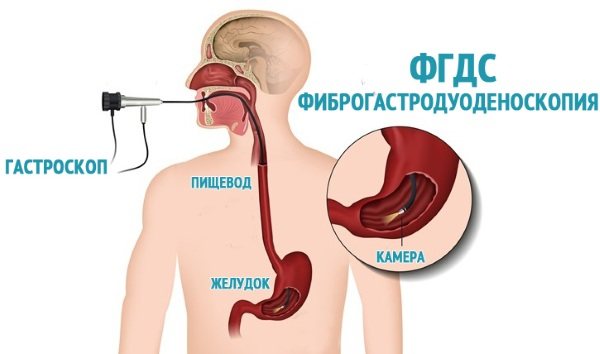
All diagnostic methods are not used for every patient. Depending on the symptoms, the doctor selects several methods to determine the cause of the discomfort.
Helminthiasis
Worms very rarely cause a sensation of movement, the only exception being enterobiasis. This disease is considered to be a childhood disease, but adults can also be carriers of pinworms. It is transmitted through contact with objects that are contaminated with the eggs of these small worms.
Worms irritate the digestive organs with the products of their vital activity, which is why flatulence, digestive problems, and pain in the navel area occur. Helminths not only provoke digestive problems, but also release toxins into the body, which negatively affect the condition. The more worms in the body, the stronger the signs of intoxication.
Among the main symptoms of the presence of worms in the body are the following:
- migraine;
- temperature increase;
- nausea;
- anemia;
- chronic fatigue.
The patient may suffer from insomnia for a long time, and children may grind their teeth in their sleep. Worms very often provoke skin rashes, and in severe cases can provoke the development of asthma.
If something is moving in the stomach, then it is advisable to get tested for the presence of worms. There are several different types of these worms, but the most common are pinworms and roundworms. When their larvae enter the body, they begin to multiply very quickly, causing various types of gastrointestinal disorders. This results in a feeling of movement.
Malignant tumors and the occurrence of adhesions in the intestines can cause movement in the intestines. In addition, other characteristic symptoms are observed. Movement may indicate the presence of a cyst in the ovaries. These are very serious diseases, therefore, immediate consultation with a doctor and proper treatment are required.
Pulsation in the abdomen is a rather unpleasant phenomenon that people of all ages experience. Most often, this is not a symptom of a serious illness, but in some cases you should be wary. Let's consider the reasons for the appearance of pulsation.
Normally, pulsation in the abdomen may appear after a long stay in an uncomfortable position, playing sports, or when exposed to factors that irritate the nervous system. In this case, you need to relax and rest a little, lie down on
side to relieve tension in the abdominal cavity. If everything goes away and the pulsation leaves no trace, then this is the norm. If you experience prolonged pain, you should consult a doctor.
Aortic aneurysm
Pulsation in the abdomen may indicate the presence of an aortic aneurysm. This is a disease of the walls of blood vessels leading to the main organ in the body - the heart. The disease does not go away on its own; it requires mandatory intervention from specialists to prevent unpleasant consequences, including death. The disease manifests itself as pulsation in the middle of the abdomen, pain, belching, bloating, and weight loss may occur. Elderly men are susceptible to the disease much more often than women, but aneurysm can appear at any age and even in the fair sex. Its presence can be determined by ultrasound by contacting
doctor with complaints of throbbing. Conservative treatment is possible only until the aorta bursts. After this, the patient’s life can last no more than 5 years. If the aorta ruptures, surgical intervention is indicated.
Pregnancy
Pulsation in the lower abdomen may indicate pregnancy. If it is accompanied by a delay in menstruation, then this phenomenon may indicate conception without a test. This is explained by the swelling of the uterus and its growth, due to which the abdominal cavity is compressed along with small vessels. Gradually, the unpleasant sensations pass, but at the beginning of pregnancy they accompany many people. Also, pulsation in the abdomen can be observed throughout the entire period of gestation. Especially when there are two or three babies, which has a strong impact not only on the mother’s organs, but also on her veins. In such cases it is necessary
relax and lie down so that the load on the abdominal cavity decreases slightly. If pulsation occurs frequently, you should consult a doctor to prevent complications.
Pulsation in the abdomen during pregnancy may indicate not only compression of the abdominal wall. Most often, in the third trimester, this is how a woman feels her baby’s hiccups. The fact is that in the last months the fetus begins to breathe independently and swallow anatomical fluid. As a result, hiccups begin - a kind of training for the digestive tract and respiratory system. This is a normal phenomenon that will accompany a woman until childbirth. To alleviate the condition, you can walk a little, eat a piece of chocolate or drink sweet juice. After a couple of minutes, the baby will stop hiccupping and causing discomfort to his mother.
Simple health recipes from gastroenterologist Antonina Shchipina.
In the navel area there is the so-called celiac trunk - a very large blood vessel. Arteries branch off from it, directing blood to almost all internal organs of the abdominal cavity.
If everything is in order in the body, then in the navel area, upon palpation, a clearly perceptible, even pulse is detected, which can be safely called the PULSE OF LIFE.
A person can independently diagnose his internal organs using the pulse in the navel area and determine which organ he has problems with.
To do this, you need to lie on the floor or on the sofa, just so that it is hard. And place both palms on your stomach in the navel area. If your pulse beats under your palms, you can be congratulated - you are practically healthy.
If the pulse is weak or you can’t hear it at all, this is a cause for concern.
A pulse beating under the palm above the navel signals problems in the liver, gall bladder, lungs, heart, esophagus, stomach, pancreas; the pulse beating below the navel - in the kidneys, uterus, bladder, ovaries.
If the pulse in the navel area cannot be heard at all, try making a diagnosis after a bath or physical activity.
More than 30 thousand species of bacteria live in our bodies. But we cannot hide under a hood: breathe sterile air, drink only sterile water. We ourselves are alive and there is an animal within us. There are excellent recipes that have been tested over the years
, which are much more effective and safer than medications.
For example, in the morning, rinse your mouth with sunflower oil for 20 minutes, preferably unrefined, it leaves a pleasant taste of seeds in your mouth. This is a powerful method of cleansing the nasopharynx and larynx. All the mucus that has accumulated there comes out, the trachea is cleaned, and the sputum is cleared well. The method is good, as is the prevention of chronic tonsillitis, otitis, sinusitis, and viral infections.
The second recipe is good because it is aimed at cleansing the intestines and gallbladder
:
Take 50g of hay, 200g of raisins, mix, add 0.2 liters of water and cook for exactly 5 minutes. Then add 200 g of holosas and put this whole tasty, sweet mixture in the refrigerator. We start taking it on the waning moon, after the full moon, 1 tbsp. spoon before eating. This is one of the most powerful recipes for cleansing the intestines and gallbladder. Even a small child can be given 1 tsp of this mixture. Take for 2 weeks.
Pulsation in the abdomen is a rather unpleasant phenomenon that people of all ages experience. Most often, this is not a symptom of a serious illness, but in some cases you should be wary. Let's consider the reasons for the appearance of pulsation.
Normally, pulsation in the abdomen may appear after a long stay in an uncomfortable position, playing sports, or when exposed to factors that irritate the nervous system. In this case, you need to relax and rest a little, lie down on
side to relieve tension in the abdominal cavity. If everything goes away and the pulsation leaves no trace, then this is the norm. If you experience prolonged pain, you should consult a doctor.
Aortic aneurysm
Pulsation in the abdomen may indicate the presence of an aortic aneurysm. This is a disease of the walls of blood vessels leading to the main organ in the body - the heart. The disease does not go away on its own; it requires mandatory intervention from specialists to prevent unpleasant consequences, including death. The disease manifests itself as pulsation in the middle of the abdomen, pain, belching, bloating, and weight loss may occur. Elderly men are susceptible to the disease much more often than women, but aneurysm can appear at any age and even in the fair sex. Its presence can be determined by ultrasound by contacting
doctor with complaints of throbbing. Conservative treatment is possible only until the aorta bursts. After this, the patient’s life can last no more than 5 years. If the aorta ruptures, surgical intervention is indicated.
Pregnancy
Pulsation in the lower abdomen may indicate pregnancy. If it is accompanied by a delay in menstruation, then this phenomenon may indicate conception without a test. This is explained by the swelling of the uterus and its growth, due to which the abdominal cavity is compressed along with small vessels. Gradually, the unpleasant sensations pass, but at the beginning of pregnancy they accompany many people. Also, pulsation in the abdomen can be observed throughout the entire period of gestation. Especially when there are two or three babies, which has a strong impact not only on the mother’s organs, but also on her veins. In such cases it is necessary
relax and lie down so that the load on the abdominal cavity decreases slightly. If pulsation occurs frequently, you should consult a doctor to prevent complications.
Pulsation in the abdomen during pregnancy may indicate not only compression of the abdominal wall. Most often, in the third trimester, this is how a woman feels her baby’s hiccups. The fact is that in the last months the fetus begins to breathe independently and swallow anatomical fluid. As a result, hiccups begin - a kind of training for the digestive tract and respiratory system. This is a normal phenomenon that will accompany a woman until childbirth. To alleviate the condition, you can walk a little, eat a piece of chocolate or drink sweet juice. After a couple of minutes, the baby will stop hiccupping and causing discomfort to his mother.
Pulsation and twitching in the stomach area is perceived by many experts as a clinical symptom, which, if it occurs frequently, may indicate the presence of pathological processes in this organ. Also, such discomfort can appear in absolutely healthy people, regardless of age.
It is considered normal when the stomach pulsates and twitches due to a person being in one position for a long time. Increased physical activity can also provoke this phenomenon, especially if it was applied to an unprepared body.
The main causes of movement
Many girls complain that they are not pregnant, something is moving in their stomach. There may be several reasons for this, and some of them are quite dangerous. In thin girls, a pulse can be felt when lying on their stomach. This is due to the fact that there is practically no fat layer in the abdominal cavity, and when the muscles are tense, pulsation can be clearly observed.
However, such a manifestation may also be a sign of a serious illness, in particular, such as an aortic aneurysm. This disease is additionally accompanied by frequent urge to go to the toilet, belching and painful sensations near the umbilical fossa. In some cases, there may additionally be nausea and bloating.
In addition, movement can occur during fermentation in the intestines, which is associated with malnutrition, as well as the installation of internal organs in their original place after childbirth. If something seems to be moving in the stomach, then the reason for this may be helminths, which are found in many people and cause great harm to the body.
Diagnosis of cutting pain in the lower abdomen
To accurately determine the cause of pain and exclude the presence of serious diseases, the doctor conducts a medical examination on the woman, which includes the following procedures:
- general blood analysis;
- Analysis of urine;
- blood biochemistry;
- cytological or urogenital examination of vaginal tissue to identify tumors and pathologies;
- Ultrasound;
- cystoscopy;
- colposcopy;
- hysteroscopy;
- hysterosalpingography;
- laparoscopy.
Before visiting a doctor, you can take non-steroidal anti-inflammatory drugs:
Even if the painful sensations disappear, you should not postpone your visit to the doctor to prescribe further drug therapy.
Peristalsis
If you feel like something is moving in your stomach, this may be due to intestinal motility. Wave-like contractions of the hollow organs are observed as food moves through them. They can be felt even through the abdominal wall. Such waves are formed regardless of a person’s desire. Not only the stomach and intestines can contract, but also the urinary tract and fallopian tubes.
The sensation of movement in the abdomen may be chaotic or have a specific direction of movement, as well as a different number of contractions. It all depends on your health and diet. Usually peristalsis is almost invisible and does not cause any particular inconvenience.
Sign of pregnancy - pulse in the navel
There is one popular sign of determining the birth of a new life by the pulse in the navel. The woman lies on her back, bends her knees and, stepping back 2 fingers below the navel, lightly presses on her stomach. If the pulse is felt, then the woman is not pregnant, and if the pulse disappears, then you can prepare for the birth of the baby.
It should be said that since the pulse below the navel is not associated with the birth of a new life, but with the blood supply to the entire body, the indicativeness of this sign is very doubtful. In addition, many women noted that they tried to track changes in heart rate during pregnancy, but did not notice anything.
Possible consequences and complications
Any discomfort in the peritoneum or any part of the body that manifests itself over a long period of time requires an urgent diagnosis. If an illness is detected: gastritis, cyst, cancer, then urgent therapy is required. Otherwise, the disease can become chronic or even cause death.
If excessive intestinal activity is detected or its peristalsis is impaired, then without proper treatment, the disease can provoke inflammation and then the consequences can be quite serious.
In case of cancer, it is important to start therapy on time, only in this case it will be possible not only to improve life, but also to prolong it. It is easier to prevent any disease than to overcome all its consequences later.
Abdominal tremors in women during pregnancy in the second trimester are the norm, meaning that the baby is fully developing. But such a symptom in the absence of pregnancy can indicate various malfunctions in the stomach, intestines, and the presence of neoplasms actively developing in the body.
That is why if movement is observed regularly, then urgent consultation with a specialist is recommended.
Nervous tic in the lower abdomen: how to treat it?
A nervous tic is a neurological disease that is characterized by involuntary contraction of various muscle groups. This disease occurs in both children and adults.
Several types of nervous tics are diagnosed, with different symptoms. A neurological disease in which a person does not control the same type of muscle contraction manifests itself in different ways: frequent blinking, twitching of the corner of the mouth, monotonous movement of the limbs, tilting the head, and so on. Sometimes facial grimaces or twitching of limbs may be accompanied by uncontrolled utterance of various sounds: screams, smacking, laughter, coughing, uttering the same type of words, howls. Depending on which muscle groups do not obey a person, facial or nervous tics of the limbs are distinguished.
Tics are divided into complex and simple types and can be local or generalized in nature. Simple neurological tics are usually local and the person does not control one muscle group.
Complex tics are most often generalized in nature and involve several muscle groups in the human body. Complex tics are uncontrollable actions that a person automatically performs: twitching of all limbs, walking monotonously in a circle or a straight line, twirling hair around fingers or shaking the whole body.
Nervous tics are primary and secondary. Primary ones are characterized by disruption of the nervous system, and secondary ones are a consequence of brain damage. The most common simple tics are the twitching of the eyelid, but it is not uncommon for a person to feel a nervous tic in the lower abdomen. With this pathology, a person feels a rhythmic contraction of the muscles of the entire peritoneum or only in one place. A nervous tic in the stomach is especially felt in a relaxed state or during periods of strong excitement.
So what causes nervous tics? Primary tic, which is characterized by a local nature, causes disturbances in the functioning of the nervous system. This is facilitated by constant overwork, stress, neuroses, and increased anxiety. Constant stress on the nervous system causes a malfunction in its functioning and because of this, brain cells are activated and begin to send signals to muscle groups. A person cannot control these signals.
Treatment of a pathology such as abdominal tics must be carried out comprehensively and under the supervision of a neurologist. First of all, a person should start taking sedatives, which will partially relieve the stress on the nervous system. Also, during the treatment period, the patient should avoid stressful conditions and get more rest.
Psychokinesiology sessions also effectively help get rid of the same type of uncontrollable muscles. These are tests and psychological exercises that are designed to normalize the regulation of the human nervous system. This method gives good results.
Another way to help the patient relax and get rid of nervous tics is holotropic breathing. This is a special breathing technique with which a person relaxes all muscle groups and heals the nervous system.
Doctors also recommend not to ignore procedures such as relaxing massage, physiotherapy, herbal medicine and aromatherapy.
In addition to the primary nervous tic, there is a more complex pathology - a secondary nervous tic, which occurs as a result of brain damage. Most often, the cause of a complex neurological disease is head injuries and infectious diseases affecting the brain. Nervous tics can also begin against the background of oxygen starvation or poisoning with toxic substances. Another cause of a serious illness is heredity. Tourette's syndrome, which causes involuntary muscle contractions, is inherited and has virtually no cure.
If it is determined that a nervous tic has developed due to oxygen starvation, the patient is prescribed drugs that restore blood circulation.
Before starting treatment for a nervous tic in the abdomen, it is advisable to find out the nature of its occurrence. A primary tic, which is local in nature, is much easier to treat than its more complex form - a secondary nervous tic.
Gas formation
The feeling that something is moving in the stomach may occur due to increased gas formation. This syndrome affects approximately 40% of the world's population. Increased gas formation processes lead to symptoms such as:
- bloating of the intestines;
- rumbling;
- bloating;
- painful sensations.
Among the main reasons for increased gas formation are an increase in the amount of air swallowed with food, disruption of the intestinal microflora, and insufficient production of enzymes. In addition, this can occur if you consume food that produces a lot of gases during digestion. This problem may be present constantly and not go away.
